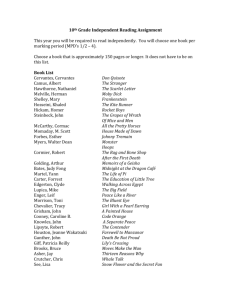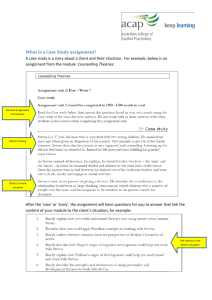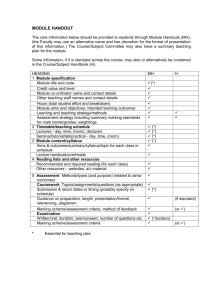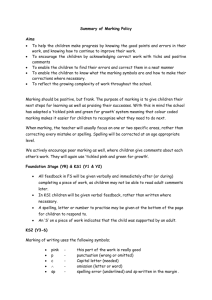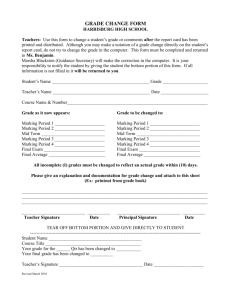POLIC014 - Hutton Church of England Primary School
advertisement
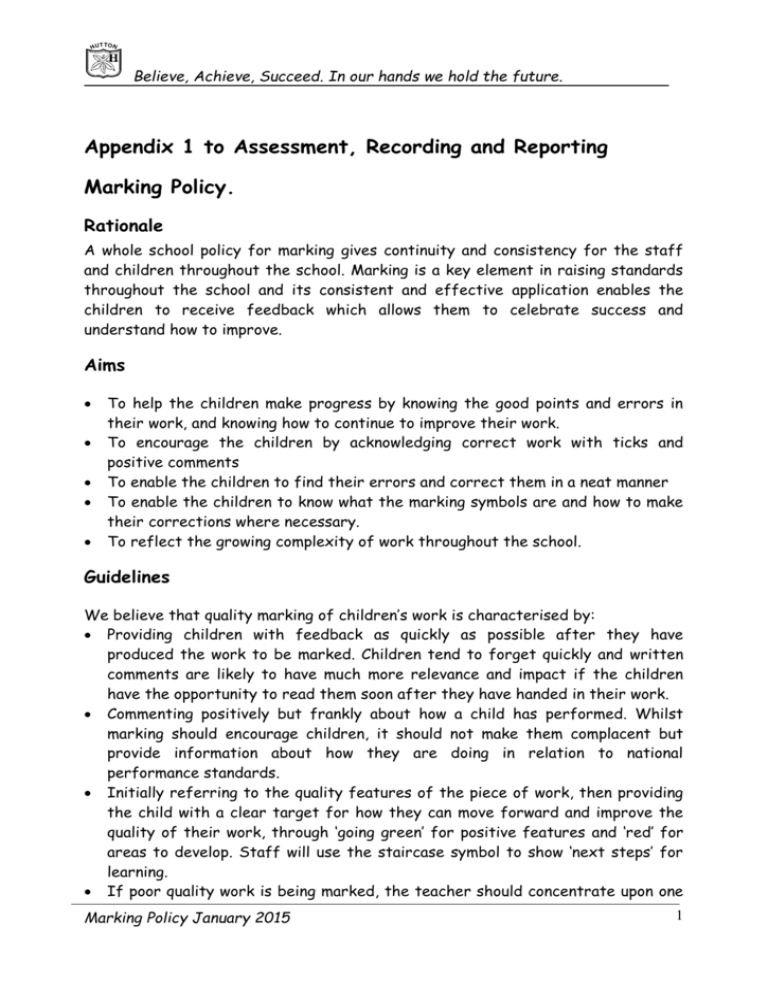
Believe, Achieve, Succeed. In our hands we hold the future. Appendix 1 to Assessment, Recording and Reporting Marking Policy. Rationale A whole school policy for marking gives continuity and consistency for the staff and children throughout the school. Marking is a key element in raising standards throughout the school and its consistent and effective application enables the children to receive feedback which allows them to celebrate success and understand how to improve. Aims To help the children make progress by knowing the good points and errors in their work, and knowing how to continue to improve their work. To encourage the children by acknowledging correct work with ticks and positive comments To enable the children to find their errors and correct them in a neat manner To enable the children to know what the marking symbols are and how to make their corrections where necessary. To reflect the growing complexity of work throughout the school. Guidelines We believe that quality marking of children’s work is characterised by: Providing children with feedback as quickly as possible after they have produced the work to be marked. Children tend to forget quickly and written comments are likely to have much more relevance and impact if the children have the opportunity to read them soon after they have handed in their work. Commenting positively but frankly about how a child has performed. Whilst marking should encourage children, it should not make them complacent but provide information about how they are doing in relation to national performance standards. Initially referring to the quality features of the piece of work, then providing the child with a clear target for how they can move forward and improve the quality of their work, through ‘going green’ for positive features and ‘red’ for areas to develop. Staff will use the staircase symbol to show ‘next steps’ for learning. If poor quality work is being marked, the teacher should concentrate upon one Marking Policy January 2015 1 Believe, Achieve, Succeed. In our hands we hold the future. specific feature of the work that the child needs to improve upon. This may also be appropriate for work of a higher quality. Children should not be given too many things to think about at once. Marking comments should refer specifically to the Learning objectives or their targeted learning. Other areas will be recorded through the marking code. Teacher comments must be legible — the teacher’s own handwriting is a model for the children’s. Providing children with sufficient time to read and think about the teacher’s comments (and ask questions) when their work is handed back to them. We aim to create a culture where children have time to think about what they have done well and how they can improve. Teachers modelling to children how their work could have been improved by writing something out in the correct way or sharing it in plenary sessions. Teachers adopting an analytical and diagnostic approach to marking children’s work. On occasions children may mark other children's work, in coloured pencil, when directed by teacher to do so. This will be recorded through the use of a different colour to show it has been peer marked. All work is to be dated, e.g. 17th February 2012 on written work, 17.02.12 on Mathematical work. Teacher may date work for those children who require it. Children will make self assessments to show how they felt they coped with the work before handing it in. This will be done through a code of smiley faces to express how comfortable they were with the work and should be accompanied by a comment as soon as the child is able to record which aspects they found challenging or too easy. Merit marks will be recorded and ‘crossed off’ as they are recorded on the chart in the classroom. Writing KS1 It should be appreciated that some children will not be able to read their comments but will get verbal feedback. Written comments are there for interested readers e.g. parents. Work is looked at with the children and ticked when correct. If verbal comments are made a VF can be recorded as evidence of verbal feedback. A positive comment may be added at the end of the work, a stamp or sticker will be used to reward the child for exceptional effort or achievement, and Marking Policy January 2015 2 Believe, Achieve, Succeed. In our hands we hold the future. occasionally the child may go to the Head to show their work as an extra reward. One key word may be selected by the teacher for Look/Say/Cover/Write/Check (L/S/C/W/C) at the bottom of the page, or where a child has formed a letter incorrectly the correct letter formation may be practiced at the bottom of the page. Up to 3 words may be selected for L/S/C/W/C as the children progress through Y1. KS1 children have word mats to help them spell words correctly. The teacher underlines miss-spelt words when the child brings work and corrected above by the child using wordbooks, dictionaries, or with the help of the teacher. If it is a very long piece, words may be corrected directly by the teacher. L/S/C/W/C is also used at the teacher's discretion. They use the same symbols key as the teachers as illustrated below:green c sp // - this part of the work is really good Capital letter (needed) spelling error (underlined) and sp written in the margin . paragraphs Marking code VF – verbal feedback S – supported by an adult. Writing KS2 The use of white boards used individually, in pairs and in groups, has radically altered the ways in which the drafting process is carried out and children often ‘try out’ ideas before they commit them to paper. Editing is carried out at this drafting stage and the children are encouraged to be thorough editors. The children are also encouraged to edit each other’s work. The concept of ‘Response Partners’ can be used effectively in KS2 where the children are taught to develop the skills of a critical friend. Marking Policy January 2015 3 Believe, Achieve, Succeed. In our hands we hold the future. They use the same symbols key as the teachers as illustrated below:green p c sp // g m v / T - this part of the work is really good punctuation (wrong or omitted) Capital letter (needed) omission (letter or word) spelling error (underlined) and sp written in the margin . paragraphs target – not met your target grammatical error make the meaning clear vocabulary – better vocabulary should be chosen start a new line for speech Obviously the use of dictionaries and spell checkers where available is encouraged at all times and teachers may choose to highlight words in the child’s work for Look/Cover/Write/Check at the bottom of the page. These may form the focus for further word level work. Mathematics KS1 Correct work is ticked and a comment or sticker/stamp may be added. The following symbols are used where errors occur: __ (error) (for correct answer to be put in) (underlining for a reversed number, which is then corrected 3 times either over dotted examples done by teacher or copying the teachers correct example). KS2 The following symbols are used: (incorrect) Children should not draw boxes round calculations but write them in rows separated by a double row. If they have to put down figures in a column care Marking Policy January 2015 4 Believe, Achieve, Succeed. In our hands we hold the future. should be taken to make sure that the figures are in the correct place e.g. Th H T U All work is written in pencil thus allowing changes to calculations without a messy crossing out. Children should be trained, encouraged and praised for writing numbers in the squares (that is why they are there and encourages the children to understand place value). The shortened version of the date should be at the top of each single piece of work and underlined carefully with a ruler. A very short summary of the learning objective should be written at the start of each piece of work. In KS1 this may be done by teachers or children. All lines must be drawn with a ruler. Policy reviewed: January 2015 To be reviewed: January 2016 Ratified by Curriculum and Standards Committee on behalf of the Governors: Mary Potter 13/1/15 (signed: Chair of Curriculum and Standards Committee) Marking Policy January 2015 5 Believe, Achieve, Succeed. In our hands we hold the future. Appendix A Sampling feedback Date: Subject: Year: Teacher: Children’s work AA: sampled A: BA: Does the work fit with the planning? Is the work carefully thought out by the child? Does the marking let the child know what has been done correctly and incorrectly? Does the marking give feedback to the child on how to do better next time? Is the work well presented? Dated/L.O. Underlining Good handwriting Tidily written Marking Policy January 2015 6 Believe, Achieve, Succeed. In our hands we hold the future. Is the learning objective obvious, written either by the child or the teacher? Is there enough evidence that the child has understood the objective? Is there evidence of differentiated work? Is there evidence of high expectations by the teacher? General comments Marking Policy January 2015 7


